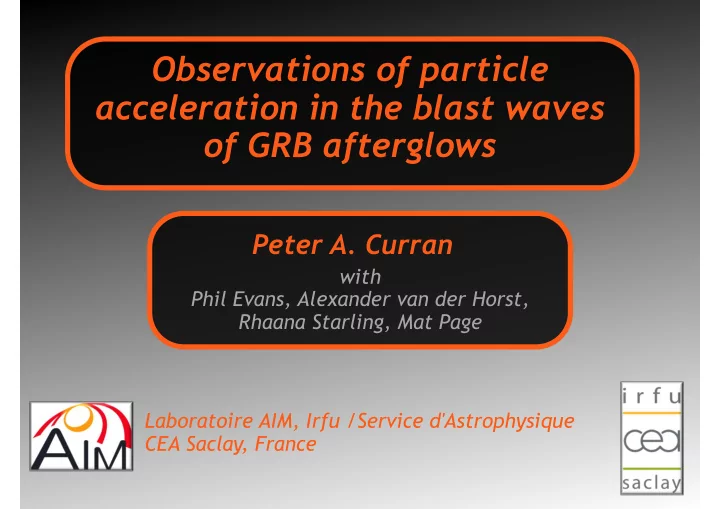

Observations of particle acceleration in the blast waves of GRB afterglows Peter A. Curran with Phil Evans, Alexander van der Horst, Rhaana Starling, Mat Page Laboratoire AIM, Irfu /Service d'Astrophysique CEA Saclay, France
GRB afterglows Electrons are accelerated by shock… emit synchrotron radiation External shocks: X-ray, optical, radio (Piran 2003)
GRB Synchrotron spectra Electrons are accelerated by shock… emit synchrotron radiation Cooling break freq. Optical X-ray (Slow cooling, adiabatic expansion) (Sari et al. 1998)
Fermi acceleration of electrons Electrons are accelerated by shock… to a certain distribution (value of p dependent on the underlying plasma physics) Electron energy distribution Number of electrons with Energy, E N(E) ∝ E -p p – electron energy distribution index Energy, E
Fermi acceleration of electrons Single, discrete value of p ? Or a distribution? What distribution? How does measured value compare to theory/ simulations? Universal value or variation between sources*? * GRB ( p~2 -3 ), Cosmic Rays ( p ≈ 2. 5-2.7), X-ray binaries ( p ≈ 2.6, σ ≈ 0.4), AGN ( p~3)
Derivation of p X-ray spectra ➝ p( β X , N H ) ⇒ multiple options ⇒ synchrotron cooling frequency above/below Compare predictions of p to light curves (optical & X-ray: small sample) to decide which value of p is correct
Distribution of p BeppoSAX & Swift (16 GRBs) Not consistent with single, discrete value (Starling et al. 2008; Curran et al. 2009)
Probability distributions 0.5 Cooling frequency: ( free parameter ) > X-ray < X-ray Transform p to β
X-ray spectral index, β X Swift X-ray Telescope (XRT) ( ~ 300 bursts) i) Assume underlying p distribution ii) Find most-likely parameters iii) Test hypothesis (via Monte Carlo) (data from Evans et al. 2009)
Monte Carlo hypothesis test ~10 5 synthetic data sets
Distribution of spectral index, β X Swift XRT ( ~ 300 bursts) Single discrete value of p ? synthetic data (Curran et al. 2010)
Distribution of spectral index, β X Swift XRT ( ~ 300 bursts) Not consistent with single, discrete value synthetic data (Curran et al. 2010)
Distribution of spectral index, β X Swift XRT ( ~ 300 bursts) Gaussian distribution of p ? (p =2.39, σ =0.6) synthetic data (Curran et al. 2010)
Distribution of spectral index, β X Swift XRT ( ~ 300 bursts) Consistent with a Gaussian distribution p =2.39, σ =0.6 (Curran et al. 2010)
Distribution of p via temporal indices X-ray spectra ➝ p( β X , N H ) ⇒ multiple options X-ray light curves ➝ p(indices, density structure, accretion) & accuracy of fit, model dependent ⇒ multiple options
Distribution of p via temporal indices Totally independent method, with different data! Preliminary p ≈ 2.36, σ≈ 0.36 ( ~ 180 bursts) (Evans et al. in preparation, using model of Van Eerten & Wijers 2009)
Fermi acceleration of electrons Q: Single value of p ? Distribution of p ? What distribution? Q: Single value of p ? Distribution of p ? What distribution? A: Gaussian distribution at p =2.39 and standard deviation, σ =0.6 A: Gaussian distribution at p=2.39 and standard deviation, σ =0.6 Electron energy distribution Number of electrons with Energy, E N(E) ∝ E -p Energy, E
Only 1 spectral peak?
Only 1 spectral peak? Swift XRT ( ~ 300 bursts) ?
Only 1 spectral peak? ≤ 6% with > 94% with cooling cooling ~94%: cooling frequency frequency frequency below > X-ray < X-ray Number of trials 3 σ limit 6% 94% Fraction of GRBs with ν c < X-ray (Curran et al. submitted)
Other explanations? Bimodal distribution of p, with mode of p drawn from correlated with position of cooling break? Highly convoluted! Wide distribution blurs out double peaks? Requires distribution far wider than observed Not 2 β X ( p ) relationships?
Synchrotron spectra? Smoothly broken curves ⇒ continuous range of relationships Breaks evolve in time ⇒ spectral & temporal changes (inconsistent with observations) (Granot & Sari 2002)
Other explanations? Bimodal distribution of p, with mode of p drawn from correlated with position of cooling break? Highly convoluted! Wide distribution blurs out double peaks? Requires distribution far wider than observed Not 2 β X ( p ) relationships? Inconsistent with observations No, majority of GRBs have cooling frequency below the X-rays - supported by preliminary Evans results
Conclusions Fermi acceleration can be ‘observed’ in GRBs, and parameters constrained via statistical methods Allows for comparison with other sources, as well as theory/simulations not consistent with a single, discrete value of p consistent with Gaussian of p ≈ 2.4, σ ≈ 0.6* 94% of GRBs have cooling frequency below the X-rays * Compared to Cosmic Rays ( p ≈ 2. 5-2.7), X-ray binaries ( p ≈ 2.6, σ ≈ 0.4), AGN ( p~3)
Recommend
More recommend